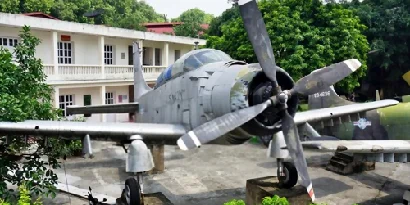Hanoi, located on the banks of the Red River, is one of the most ancient capitals in the world, where travellers can find well-preserved colonial buildings, ancient pagodas, and unique museums within the city centre.
Imperial Citadel of Thang Long
The Imperial Citadel of Thang Long is an intriguing relic of Vietnam’s history and, signifying its historical and cultural importance, is now a UNESCO World Heritage Site. Standing 40 metres high, the central flag tower is the most recognizable feature of the Imperial Citadel and is often used as a symbol of Hanoi. This was the centre of ancient Hanoi and served as the political centre for eight centuries.
Ho Chi Minh Mausoleum
Ho Chi Minh has left an indelible mark on Vietnamese history and his body is revered in Hanoi as the country’s greatest leader. Nicknamed ‘Uncle Ho’ by locals for their love towards him, his preserved body is now laid to rest in a glass case in the Ba Dinh area of Hanoi. This is more than a tourist attraction, it is a part of living history and a visit here stays long in the memory. The sombre building was modeled after Lenin’s mausoleum in Moscow.
The Perfume Pagoda
The Perfume Pagoda is a dramatic temple complex believed to have been first built in the 15th century. This series of Buddhist temples is built into a mountain range in a maze of alleyways, carved into a rock with rich forest and flowing streams surrounded. Located around 60 km south of Hanoi in the Son Mountains, the journey here is an experience in itself: first you must take a two hour journey by car or bus before travelling by boat to the foot of the mountains.
Sword Lake and Ngoc Son Temple
Sword lake is located in the center of Hanoi and considered a symbol of the city. Travelers and locals alike head to Sword Lake to seek a place to get away from the noise of the bustling city. Peaceful and quiet, the lake surrounds Ngoc Son Temple, located at the middle of the lake, on a small island.
Dong Xuan Market
Dong Xuan Market is the largest of its kind in Hanoi. Housed within a four-storey Soviet-style building, this sprawling complex offers an extensive collection of fashion, apparels and souvenirs at a competitive price. Even if you’re not interested in printed T-shirts or cheap sunglasses, it is still fascinating to see the comings and goings of the local traders, and there is a wet market on the ground floor where the sights and smells of exotic products mesmerize your senses.
Ba Vi National Park
Ba Vi National Park is located around two hours (48 km) from downtown Hanoi. Famous for its three-peaked mountain that juts steeply up into the sky and is often covered by clouds, Ba Vi National Park has breathtaking sceneries and a diverse range of jungle plants and animals. At the summit of the tallest mountain is an 11th century temple offering expansive views of the surrounding countryside, and natural hot springs on the forest floor.
Temple of Literature
A rare example of a well-preserved traditional Vietnamese architecture, the Temple of Literature honours Vietnam’s finest scholars. Founded in 1070 by Emperor Ly Thanh Tong, the attractive complex is dedicated to Confucius (Khong Tu) and was the site of Vietnam’s first university. The altars are popular because of its belief to bring good grades; while the pagodas, ponds and gardens of the five courtyards make picturesque backdrops for student graduation photos.



